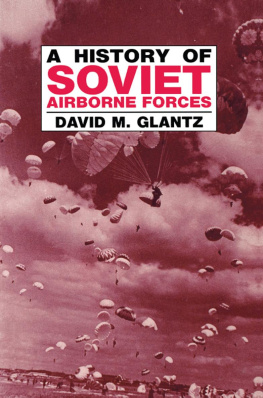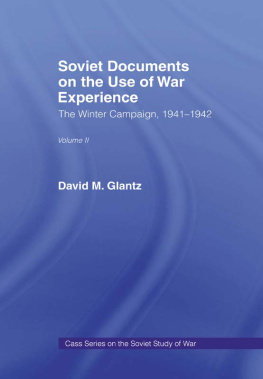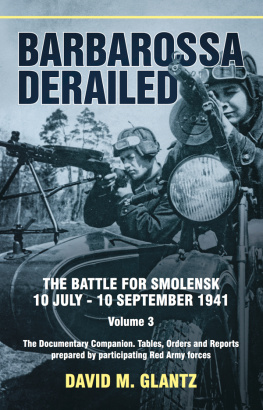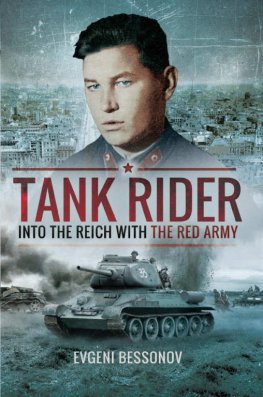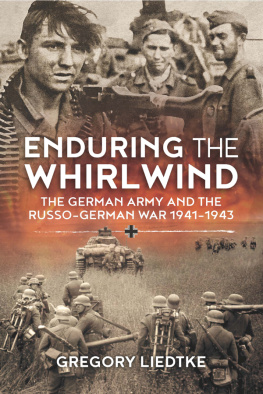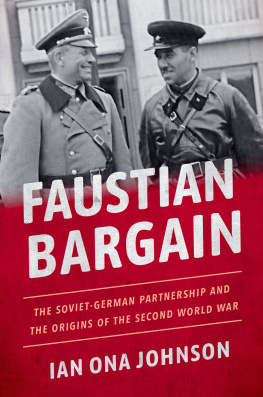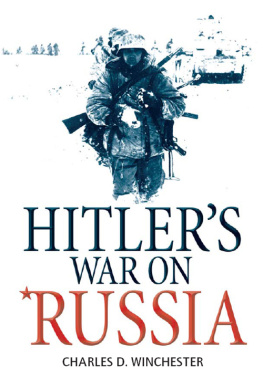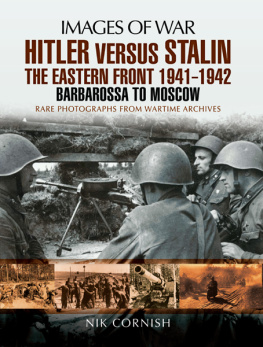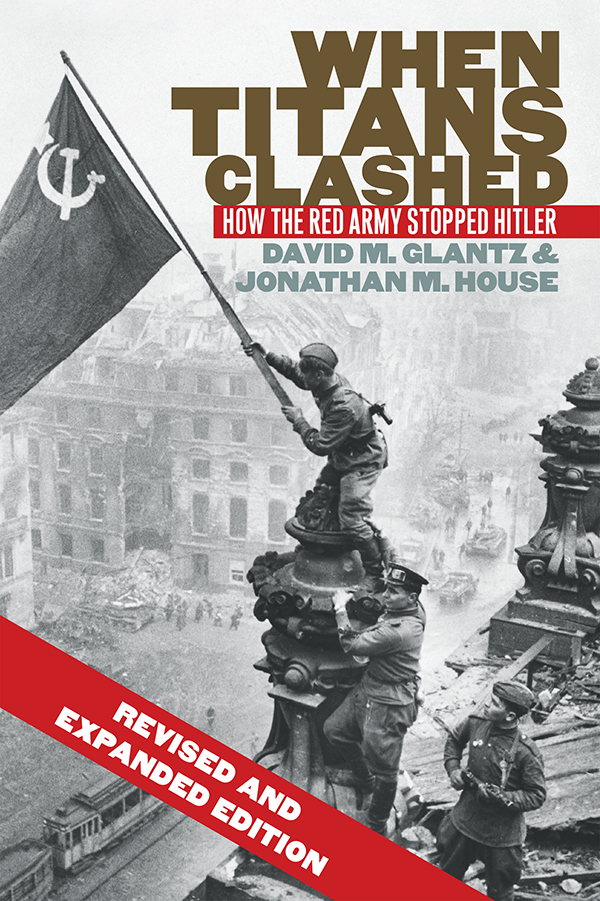CONTENTS
When Titans Clashed
MODERN WAR STUDIES
Theodore A. Wilson
General Editor
Raymond Callahan
Jacob W. Kipp
Allan R. Millett
Carol Reardon
Dennis Showalter
David R. Stone
James H. Willbanks
Series Editors
This revised edition is dedicated to Professor Theodore Wilson,
who made the original project possible
2015 by the University Press of Kansas
All rights reserved
Published by the University Press of Kansas (Lawrence, Kansas 66045), which was organized by the Kansas Board of Regents and is operated and funded by Emporia State University, Fort Hays State University, Kansas State University, Pittsburg State University, the University of Kansas, and Wichita State University
Library of Congress Cataloging-in-Publication Data
Glantz, David M.
When titans clashed: how the Red Army stopped Hitler / David M. Glantz, Jonathan M. House. Revised and expanded edition.
pages cm.(Modern war studies)
Includes bibliographical references and index.
ISBN 978-0-7006-2120-0 (cloth: alk. paper)
ISBN 978-0-7006-2121-7 (pbk.: alk. paper)
ISBN 978-0-7006-2152-1 (ebook)
1. Soviet Union. Raboche-Krestianskaia Krasnaia ArmiiaHistoryWorld War, 19391945.
2. World War, 19391945CampaignsEastern Front. I. House, Jonathan M. (Jonathan Mallory), 1950-II. Title.
D764.G557 2015
940.54217dc23
2015020379
British Library Cataloguing-in-Publication Data is available.
Printed in the United States of America
10987654321
The paper used in this publication is recycled and contains 30 percent postconsumer waste. It is acid free and meets the minimum requirements of the American National Standard for Permanence of Paper for Printed Library Materials Z39.48-1992.
Maps, Illustrations, and Tables
MAPS
ILLUSTRATIONS
Illustrations
TABLES
In the Text:
Preface to the Revised and
Expanded Edition
When the first edition of this book was published in 1995, the authors gratefully benefited from the modest first wave of archival materials released by the Russian Federation, which increased our knowledge of the war twofold and enabled us to add substantial Russian context and detail to what had previously been a largely German perspective on the war. Thanks to those initial releases, the books first edition restored a modicum of truth and accuracy to the Soviet side of the war by identifying battles forgotten or concealed for political reasons and by adding more candid detail to the description of battles already well known. Likewise, a clearer understanding of what the Red Army actually achieved tempered the obvious German bias so evident in the historiography on the war during the Cold War years. However, despite those beneficial releases, yawning gaps still existed in the historical record of the war in 1995, the most vexing of which was the paucity of accurate numbers quantifying the scope and ferocity of the struggle. Now, most of those gaps have been filled, and the missing numbers are becoming readily available.
With this passage of time, the amount of archival materials available to flesh out an accurate description of the war, particularly from the Soviet perspective, has increased more than a hundredfold. Up to 60 percent of the wars content remained largely conjecture in 1995, but by 2015, this figure had decreased to roughly 10 percent. As a result, clarity is replacing opaqueness and truth is steadily winning out.
Readers have the right to know what is new and different about this edition. First and foremost, this edition exploits the massive amount of previously unavailable archival documents related to the war that the Ministry of Defense of the Russian Federation has released since 1995. These documents include many, if not most, of the wartime directives, orders, and reports prepared by the Soviet State Defense Committee (GKO); the Stavka (headquarters of the Supreme High Command); the Red Army and Navy General Staffs; the Peoples Commissariat of Defense (NKO) and its many subordinate directorates; the Red Armys operating fronts, armies, and in some cases corps, divisions, and brigades; and the Peoples Commissariat of Internal Affairs (NKVD) and its subordinate directorates for border guards, as well as operational and convoy and installation security troops. The twenty-six tables in the books second edition (versus the five in the 1995 edition) attest to the magnitude of new statistical evidence describing the scale of Soviet participation in the war.
Among other things, the new edition broadens the definition of available manpower on both sides, including such overlooked groups as NKVD troops, Axis satellite armies, and dissident forces that the Germans recruited in the non-Russian portions of the USSR. It rejects traditional efforts by German generals to hold Adolf Hitler solely responsible for all German errors and atrocities. And it includes recent scholarship on German security actions and exploitation of the occupied rear areas.
Aside from official Russian releases of archival materials, cooperative programs between the Russian and U.S. armies in the early 1990s resulted in the release of extensive Red Army and Navy General Staff multivolume collections (Sborniki) of war experience materials, organized topically and functionally. These included detailed and candid studies, formerly classified, of wartime military operations (such as Moscow, Belorussia, Berlin, and the battle for the Dnepr River) and subject areas related to the actual conduct of warfare (offense, defense, river crossings, amphibious and airborne operations, and so forth). Supplementing these materials were numerous dissertations on military subjects prepared by graduates of the Voroshilov Academy of the General Staff and a wide array of textbooks on wartime military operations used in education by the Frunze Academy.
Above and beyond official sources, since 1995 a new generation of civilian Russian military historians have emerged, scholars who have accomplished extensive research of their own and written often refreshingly candid studies of the war as a whole, together with its component military operations. As evidenced by the new bibliography, these too have become fodder for this books second edition.
If military operations provide the backbone and skeleton of the German and Soviet war efforts, equally vital political, economic, and social issues provide rationale and context for those operations and, at the same time, reflect what took place on the battlefield. For example, a more thorough understanding of what the Red Army hoped to achieve militarily now provides keener insights into what Joseph Stalin hoped to achieve politically during and after the war. Likewise, revelations concerning the human and economic costs of the war generate better understanding of the conflicts impact on Germany and the Soviet Union socially and economically, while also underscoring its ferocity in terms of human misbehavior and resultant atrocities. Closely associated with these themes are tragedies and crimes resulting from extreme Nazi racial theories and the excesses of Communist totalitarianism (for instance, the Holocaust, Katyn, and Baba Iar).
The collapse of the German Democratic Republic disclosed many German military documents that were previously thought lost in the destruction of the war. This treasure trove provided the raw data for a magisterial German official history of the war, as well as numerous monographs by Western scholars on aspects ranging from the number of tanks present at Kursk to the internal workings of the German war economy. This second edition includes the key findings of this new generation of Western historians, resulting in a more balanced account that seeks to reflect the major issues confronting both sides in the conflict.


